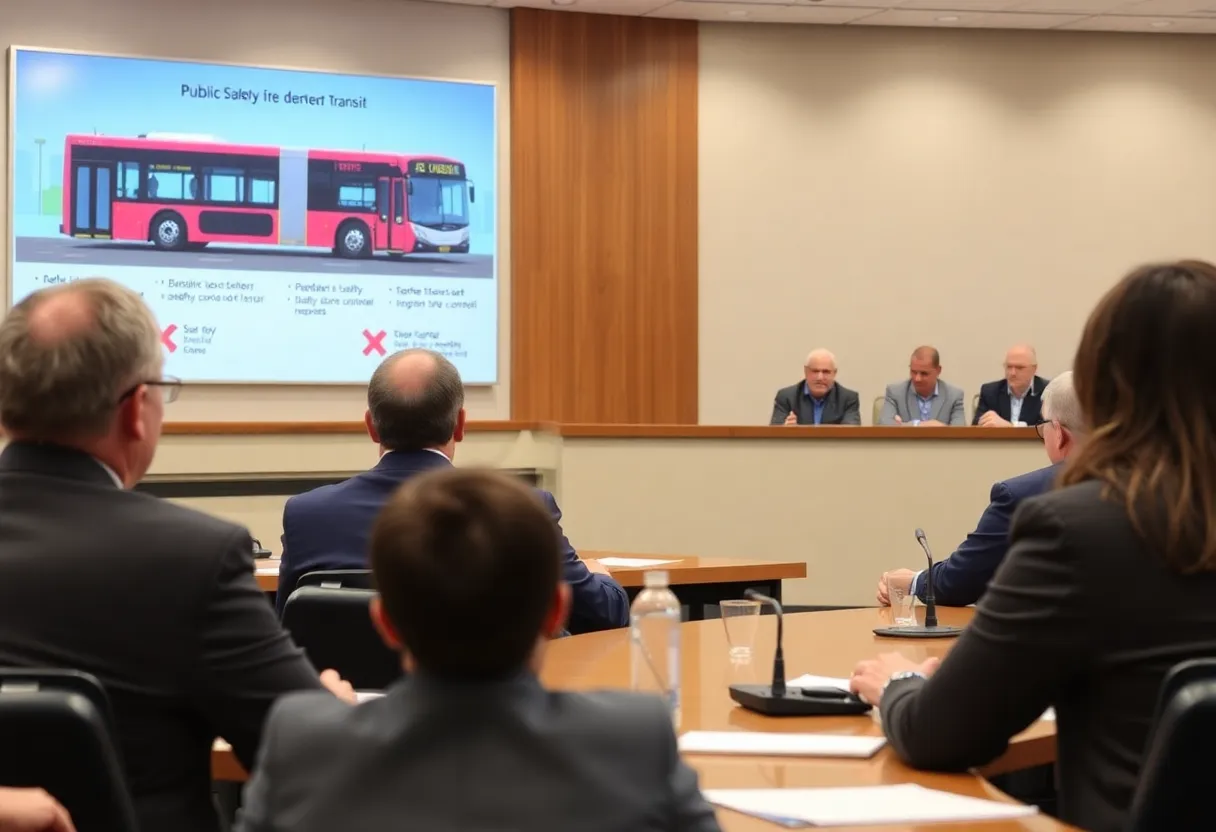Tucson, October 6, 2025
The Tucson City Council will discuss safety improvements for the Sun Tran public transit system following a rise in blind spot accidents. With a focus on reducing risks after a recent bus collision, proposals include installing advanced sensors and enhanced driver training programs, projected to cost $2 million. Local residents demand accelerated implementation to ensure safer travel as public transit usage grows in the city.
Tucson City Council to Address Sun Tran Transit Safety Amid Rising Accidents
Tucson – The Tucson City Council is preparing to discuss critical safety improvements for the Sun Tran public transit system, focusing on reducing blind spot accidents that have been increasing in recent years. This comes in response to heightened public concern following a recent collision involving a transit bus, with proposed measures including the installation of advanced sensors and enhanced driver training programs at an estimated cost of $2 million.
Local residents have voiced strong demands for faster implementation of these safety enhancements, citing the growing reliance on public transportation in the city. As Tucson’s commuter base expands, ensuring safer travel options has become a priority to maintain trust in the system and support daily mobility needs.
Details of the Proposed Safety Measures
The agenda for the upcoming council meeting centers on addressing vulnerabilities in bus operations, particularly blind spots that contribute to pedestrian and vehicle incidents. Advanced sensors, such as ultrasonic and camera-based detection systems, would be integrated into Sun Tran buses to alert drivers of potential hazards in obscured areas. Complementing this technology, comprehensive driver training programs aim to sharpen response times and awareness through simulated scenarios and regular refreshers.
These initiatives are projected to cost $2 million, with funding potentially drawn from the city’s transportation budget and federal grants allocated for public transit safety. The council’s discussion will evaluate the feasibility, timeline for rollout, and long-term maintenance of these upgrades, aiming to balance immediate action with fiscal responsibility.
Recent Incident Sparks Community Urgency
A recent collision involving a Sun Tran bus has amplified calls for quicker action, highlighting the real-world risks faced by commuters and pedestrians alike. While no major injuries were reported in this specific event, it underscores a pattern of rising blind spot-related accidents across the transit network. Community members, including regular bus users and safety advocates, have attended preliminary sessions to emphasize the need for proactive measures before further incidents occur.
The push for change aligns with Tucson’s broader efforts to enhance urban mobility as the population grows. Public transit usage has surged with increased downtown development and remote work trends, placing additional pressure on the system to operate reliably and securely.
Councilmember Lopez’s Focus on Commuter Support
Among the council, emphasis has been placed on bolstering public transport safety to accommodate Tucson’s expanding commuter base. This perspective frames the safety upgrades not just as reactive fixes but as essential investments in the city’s infrastructure. By prioritizing these improvements, the council aims to foster a more inclusive transportation network that encourages greater ridership and reduces reliance on personal vehicles, potentially easing traffic congestion and environmental impacts.
Background on Sun Tran Challenges
Sun Tran, Tucson’s primary bus service, has long served as a vital lifeline for thousands of residents, connecting neighborhoods, workplaces, and essential services. However, like many urban transit systems, it faces ongoing challenges with safety in high-traffic areas where blind spots pose significant risks. Data from recent years shows a steady uptick in minor accidents attributed to these visibility issues, prompting internal reviews and now, formal council intervention.
The proposed $2 million investment reflects a strategic approach, drawing on proven technologies used in other cities’ transit fleets. Advanced sensors, for instance, have demonstrated up to a 30 percent reduction in collision rates in similar implementations elsewhere. Driver training, meanwhile, builds on existing programs but would expand to include more hands-on, technology-integrated modules to adapt to modern bus designs.
Residents’ demands for swift action stem from everyday experiences with the system, where crowded routes and varying road conditions amplify safety concerns. The recent collision served as a catalyst, bringing these issues to the forefront of public discourse and council priorities. As the meeting approaches, stakeholders expect a clear path forward, with potential approvals paving the way for pilot programs on high-risk routes.
Beyond immediate safety, these enhancements could yield broader benefits for Tucson’s economy and quality of life. Safer transit encourages more people to forgo car ownership, supporting local businesses through increased foot traffic and reducing emissions in a city already grappling with air quality issues. The council’s deliberation will weigh these advantages against budgetary constraints, ensuring that the $2 million allocation delivers measurable improvements without overburdening taxpayers.
In the context of Tucson’s growth, where new housing and commercial developments are expanding the commuter footprint, robust public transit is indispensable. The focus on blind spot mitigation addresses a core operational flaw, positioning Sun Tran for a safer, more efficient future. As discussions unfold, the outcome could set a precedent for how the city tackles transportation challenges in an evolving urban landscape.
FAQ
- What is the Tucson City Council discussing regarding Sun Tran?
- The Tucson City Council is set to discuss Sun Tran transit safety improvements amid rising blind spot accidents.
- What proposed measures are included for safety enhancements?
- Proposed measures include advanced sensors and driver training programs costing $2 million.
- Why are local residents demanding quicker action?
- Local residents demand quicker action after a recent collision.
- What is the emphasis from Councilmember Lopez?
- Councilmember Lopez emphasized the need for safer public transport to support Tucson’s growing commuter base.
Key Features of Sun Tran Safety Improvements
| Feature | Description | Estimated Cost | Purpose |
|---|---|---|---|
| Advanced Sensors | Ultrasonic and camera-based systems to detect hazards in blind spots | Part of $2 million total | Alert drivers to potential collisions in obscured areas |
| Driver Training Programs | Simulated scenarios and regular refreshers for enhanced awareness | Part of $2 million total | Improve response times and operational safety |
This chart outlines the primary components of the proposed Sun Tran safety upgrades, focusing on technology and human factors to address rising blind spot accidents.
Deeper Dive: News & Info About This Topic
HERE Resources
Tucson Fire Department to Relocate Station 14 for Improved Service
Tucson Man Stabbed on Greyhound Bus: Victim Stable After Surgery
BioTucson Secures FDA Approval for Wearable Heart Monitor




